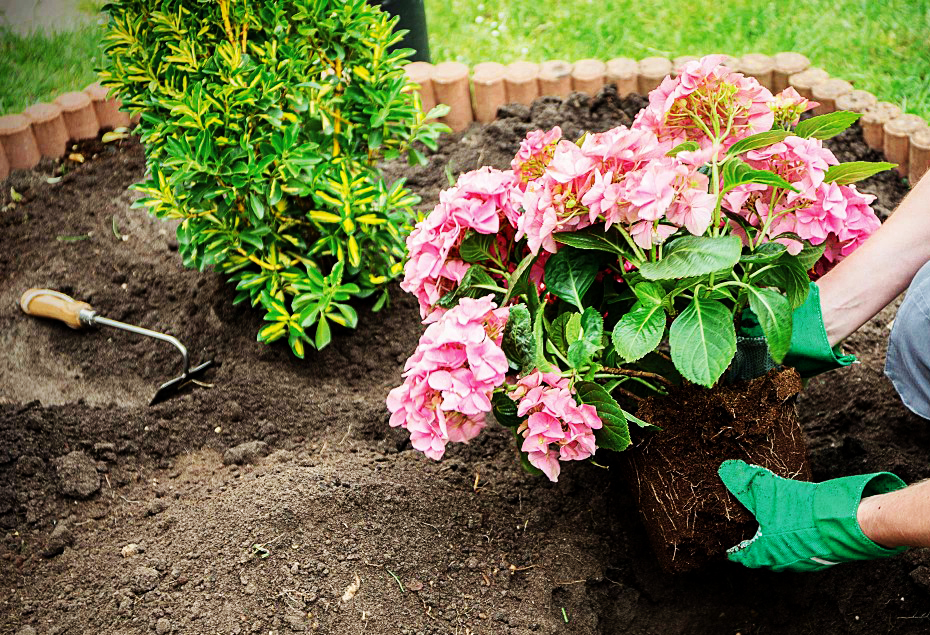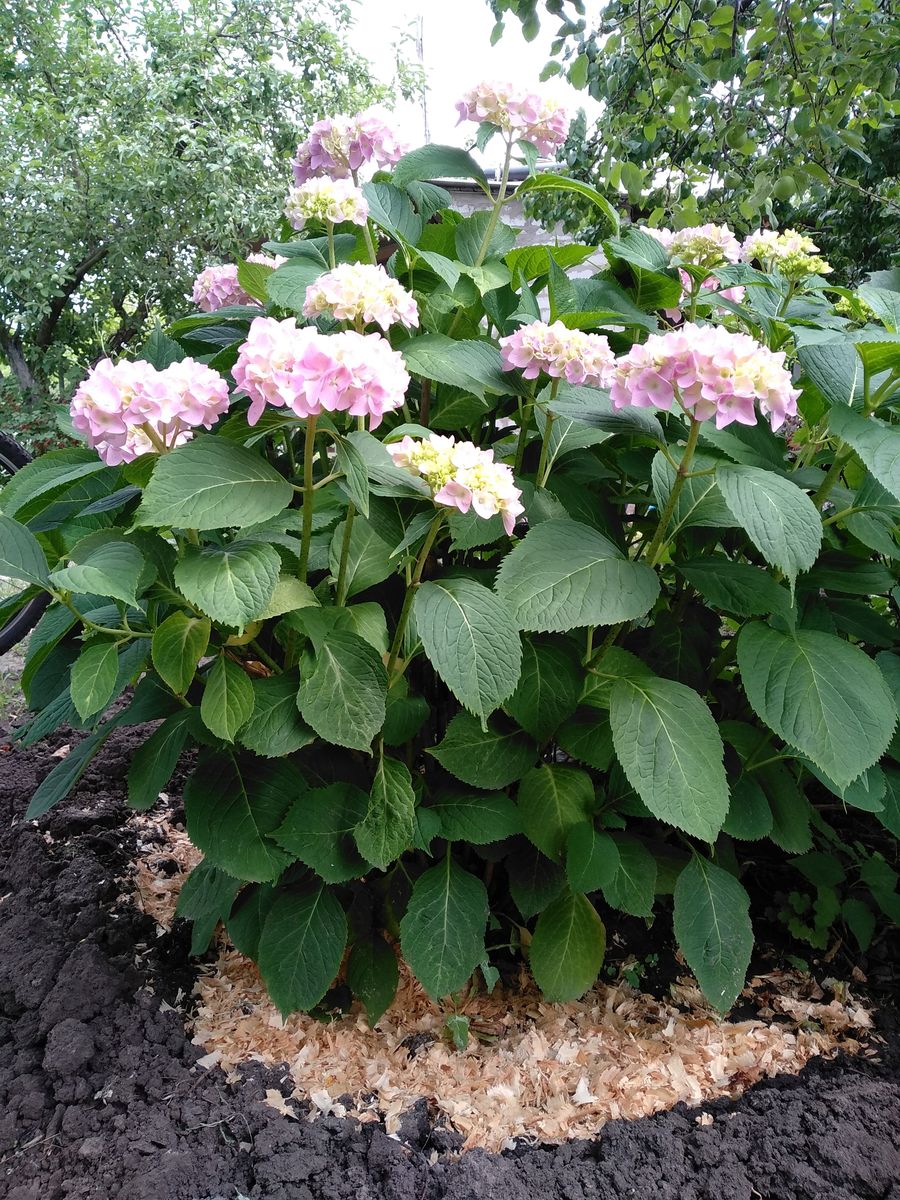Hydrangea pink - description of varieties, planting and care in the open field in the garden
Content:
Hydrangea pink is a lush and beautiful shrub that can transform any garden area. The peculiarities of the plant make it possible to plant it in almost all regions of the country. This variety has some nuances in appearance and care, which it is better to familiarize yourself with in advance.
Description of pink hydrangea
Garden hydrangea pink is a shrub of the Deciduous family. It is often used to decorate squares, parks and, of course, garden (summer cottages, country) plots. There are two types of such hydrangea - tree and paniculate. In Russian realities, the first option is most often planted.
Origin
The plant is native to East Asia. The largest number of species grows in Japan and China. It was brought to Europe only in the XIV century - to decorate the gardens of representatives of the upper classes of England and France.
At the beginning of the 16th century, hydrangea appeared in Russia, but only in two colors - white and pink.
Features of the
Delicate pink hydrangea blooms magnificently, with large inflorescences. Small flowers in the center, larger ones on the sides. It is this feature that makes the plant so interesting and unusual.
The most commonly used tree type of plants. The shrub grows up to 1 meter in height. The leaves have a rich green color, the shape is elongated, closer to the oval, they last until mid-autumn (the first frost).
Pros and cons of the variety
Hydrangea is common throughout the country. The plant has certain advantages:
- wide range of colors and shades;
- withstands wintering without replanting;
- fast regeneration (after temperature changes, trimming, other negative moments);
- immune to insects, diseases.
Disadvantages include care, soil requirements and other specific disadvantages inherent in specific varieties.
Winter hardiness
North American varieties, which appeared in the 80s of the twentieth century, can withstand temperatures down to -15 ° C. Species bred in Europe hibernate at -20 ° C. Frost-resistant species include:
- Firewox Pink ("pink fireworks");
- White Ball ("white ball");
- Blue Haven ("blue sky");
- Red Sensation ("red sensation") and others.
Such varieties are suitable if the temperature in winter permits. Otherwise, a transplant or special shelter will be required.
Varieties and varieties of pink and pale pink hydrangeas
There are many varieties of hydrangea with pink flowers. In the conditions of the Russian climate, the following varieties showed themselves best of all.
Kumiko
The official name of the variety is Hydrangea macrophilla "Kumiko".An ornamental shrub has straight stems and shoots, at the ends of which large spherical inflorescences are formed.
The variety is considered relatively frost-resistant (withstands up to -18 ° C), but requires a special coating for wintering in northern latitudes.
Bella Anna
The variety differs in the size of the inflorescences - up to 20 cm (usually about 25 cm). The tree grows up to 1.3 m in height. The period of active flowering reaches three months.
The leaves are light green in color with clearly visible veins, after the season they acquire a yellowish tint.
Sweet Fantasy
A large-leaved variety of pink hydrangea with the scientific name Hydrangea macrophylla Sweet Fantasy.
The plant reaches a height of no more than 1.2 m. The brightest color is red with rich splashes at the edges.
It blooms on the shoots of the current and next seasons. Recovers quickly after wintering.
Hanabi Rose
Low grade - maximum height 80-100 cm. Inflorescences are flattened, reaching 25 cm in diameter. Petals are pale pink, slightly double to the touch. It quickly forms shoots, pleases with flowers on the stems of the current and last seasons.
Pink pinkushen
Treelike hydrangea. The bush grows sprawlingly, with a lot of shoots.
Pink Pincusion blooms for three months - from June to August. It is often used to decorate parks, plots. The diameter of the inflorescences is no more than 15 cm.
Landing in open ground
It is necessary to familiarize yourself with the rules for planting and caring for pink hydrangea in the open field in advance - the plant is demanding in choosing a place, does not tolerate frequent transplants.
Site and soil selection and preparation
Place is the first and rather important point. Hydrangea of all varieties does not tolerate shade (some allow partial shade - a rare feature), constant transplants, as a result, ceases to grow and bloom. The soil should be clayey, acidic enough. Peat, sawdust or pine needles can be added to neutral soil.
The planting hole is prepared in advance - 50 * 40 * 40 cm. Fertilizers (humus, river sand, superphosphates and others) are added.
Next to which plants it is better to plant
Hydrangea is a large-leaved perennial shrub, so annual varieties should not be planted nearby (if there is no desire to update the design of the site annually). It is important to take into account not only the color scheme of the "neighbors", but also the general compatibility - similar requirements for soil, frequency and abundance of watering, and other points. Most often used:
- ferns - allow you to create an interesting foliage pattern on several levels;
- periwinkles, ivy - undersized varieties frame the bottom of hydrangeas;
- the cuff is soft - they have lighter leaves, add radiance to the composition.
Other options are badan, hosts, lilacs, chubushniks, hydrangeas and many others. The most colorful combination is considered to be cereals (hakonehloa, falaris, millet).
When and how to plant
In the southern regions and the Moscow region, hydrangea is planted in the fall, in Siberia - only in the spring.
In a previously prepared hole, a small mound is formed, where the seedling is placed - the roots are carefully distributed around. The planting hole is completely filled up, abundant watering is required.
Plant care
Hydrangea pink needs balanced nutrition and care.Subject to all the requirements and rules, the plant will give a lush and bright flowering.
Watering
The shrub loves regular and abundant watering - up to 30 liters every week. Before the procedure, dig in the soil - about 5-10 cm.
In addition to moistening the soil, it is necessary to spray the foliage with a spray bottle.
Fertilization and feeding
It is especially important to provide additional nutrition only to the planted plants. Mineral fertilizers are applied every spring - potassium sulfate is a must. The second time - at the time of the appearance of buds, then in the fall.
Mulching and loosening
The right mulch will retain moisture in the soil, and timely loosening will provide the required amount of oxygen to the roots. For mulching hydrangeas, the following are suitable:
- crushed bark (it is important to have a mark "sterilized" or "composted");
- coffee grounds - oxidizes the soil, you can take it in a cafe or coffee shop;
- peat moss;
- pine straw and others.
It is important to take into account that certain types of mulch reduce the acidity of the soil, which affects the color of the buds. Loosening is carried out regularly at a distance of 50-60 cm around the bush. Depth - no more than 10 cm, so as not to damage the root system.
Pruning
The main pruning - the formation of a bush - is carried out in early spring (end of March). The secateurs must be treated with a disinfecting solution and sharpened.
Important rules:
- it is unacceptable to cut branches manually;
- the weather should be sunny, calm;
- hemp, cuts must be treated with garden varnish or its substitutes.
Cut at a slight slope. If the bush has already grown, you cannot cut all the branches at once, it is better to do a complete pruning in stages.
Preparing for winter
Most varieties of pink hydrangea need additional shelter for the winter. The main ways are:
- sprinkling with foliage or sawdust;
- construction of "boxes" for each bush of boards or mesh, cover the top with polyethylene or other covering material.
Reproduction
The easiest way is to buy seedlings in special bins. The disadvantages are the cost, the lack of the desired grade. Hydrangea can be propagated independently by the following methods.
Growing from seeds
The seeds of the plant do not require pre-treatment, they are immediately planted in pots (boxes, other). The soil is moistened, the seeds are not buried, they are covered with foil or glass. The first shoots appear on average after three weeks.
Cuttings
The best way to propagate pink hydrangea is by cuttings. The time of bud formation (mid-July) is considered suitable. A green stalk is used - the part of the stem with leaves and buds.
Dividing the bush
This method is used only during plant transplantation. It is permissible to separate bushes of all types of hydrangea (except paniculate).
Period - spring (with the onset of heat, but before flowering). First, the bush is well watered, then dug out. The roots are washed from the ground and separated.
Layers
The method is used in early spring, before the formation of kidneys. Stages of work:
- Spud the bush, level the earth.
- Make radial grooves, depth no more than 2 cm.
- Put one stem in each, sprinkle, but leave the top on the surface.
How to change the color of a pink hydrangea
The petals of a plant can change color due to certain chemical reactions - white can turn pink, then blue. Home ways to change the color of inflorescences:
- watering with diluted aluminum salt, citric acid - allows you to get blue and blue colors (the rarest);
- adding dolomite flour, lime - changes the color from white to pink.
In the first case, the acidity of the soil increases, in the second it decreases, the soil becomes more alkaline.
Growing problems
If the plant has poor growth, insufficient or absent flowering, it is necessary to check the level of illumination, the amount of watering, the condition of the roots (it is forbidden to huddle deeper than 10 cm). It's too early to judge if the hydrangea was just transplanted.
Why does pink hydrangea bloom white? For pink hydrangea, soil acidity is important - an acceptable level of 6.5 pH (neutral). Under the bush, you can pour a little crushed chalk or lime, soil with a neutral level of acidity. If the soil was alkaline, the color will return to normal.
Typical diseases and pests
Diseases manifest themselves from poor conditions - sunburn, excess or lack of watering, disturbed mineral balance. Major diseases:
- chlorosis (iron deficiency, lime supersaturation);
- spots (white, from burns);
- dry blackening leaves (excessive sun, high water hardness);
- wet dark leaves (from spraying with herbicide fertilizers).
Fungal rot (white, gray), downy mildew, powdery mildew and others are also possible. Hydrangea pests are standard, garden pests (aphids, spider mites, rootworm nematodes, slugs).
If the disease is diagnosed, fungicides are used. If pests attacked, parasites settled on the bushes, you will have to buy insecticides.
The use of pink hydrangeas in landscaping
Hydrangeas often become central elements in the design of sites. For example, Lady Fries is used in mixborders. They take into account not only the compatibility of plants, but also the general style. Paniculata are suitable for landscape design in the Russian style, and they are also planted next to artificial reservoirs.
For hedges, several varieties of hydrangeas are used, forming them by cutting to the desired size. Single bushes look beautiful if the surrounding lawn is neat and uniform.
Pink hydrangeas are lush and vibrant plants. It is necessary to take proper care of it. But if you take into account the recommendations of experts, it will turn out to decorate the site with extraordinary bushes for several years.





















